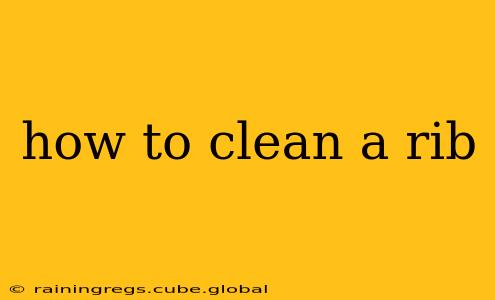Cleaning ribs properly is crucial for achieving tender, flavorful results. Whether you're working with spare ribs, baby back ribs, or St. Louis-style ribs, the process involves removing the membrane and trimming excess fat. This guide will walk you through each step, answering common questions along the way.
What is the membrane on a rib, and why should I remove it?
The membrane, a thin, papery layer on the bone side of the ribs, is tough and prevents the ribs from properly absorbing smoke and flavor during cooking. Removing it is key to achieving tender, juicy, and flavorful ribs. It's often overlooked, but this simple step makes a significant difference in the final product.
How do I remove the membrane from a rib rack?
-
Locate the membrane: Flip the rib rack over so you're looking at the bone side. The membrane will be a thin, whitish layer covering the bones.
-
Loosen an edge: Use a butter knife or your fingers to gently loosen a corner or edge of the membrane.
-
Grab and peel: Once you've got a small section loose, grab it firmly with a paper towel or clean kitchen towel for better grip. Slowly and carefully peel the membrane away from the ribs, working your way across the entire rack. It may tear in places, which is perfectly fine.
-
Dispose of the membrane: Once removed, discard the membrane.
How much fat should I trim from my ribs?
Trimming excess fat is important for preventing overly greasy ribs. However, you don't want to remove all the fat, as some fat renders during cooking and contributes to flavor and moisture. Aim for a balance: trim away thick layers of fat, leaving a thin layer (about 1/8 inch) remaining. This helps prevent overly fatty ribs while still providing enough fat for flavor.
What tools do I need to clean ribs?
You'll primarily need a sharp knife (a boning knife works well), paper towels, and possibly a butter knife to help loosen the membrane. A pair of kitchen shears can also be helpful for trimming excess fat.
Can I clean ribs the day before cooking?
Yes, cleaning ribs ahead of time is perfectly acceptable. Once cleaned, you can refrigerate the ribs until you're ready to cook them. This allows for better planning and organization.
What if I accidentally tear the membrane while removing it?
Don't worry! It's completely normal for the membrane to tear while removing it. As long as you remove the majority of it, your ribs will still cook beautifully.
What are the best tips for cleaning ribs?
- Work in a well-lit area: Proper visibility ensures you don’t miss any bits of membrane or excess fat.
- Use sharp tools: A sharp knife makes the trimming process easier and more precise, reducing the risk of damaging the meat.
- Be patient: Take your time to carefully remove the membrane and trim the fat. Rushing the process can lead to mistakes.
By following these steps, you’ll ensure your ribs are perfectly prepared for cooking, resulting in a delicious and tender final product. Remember, proper cleaning is a crucial step towards achieving perfectly cooked ribs!
